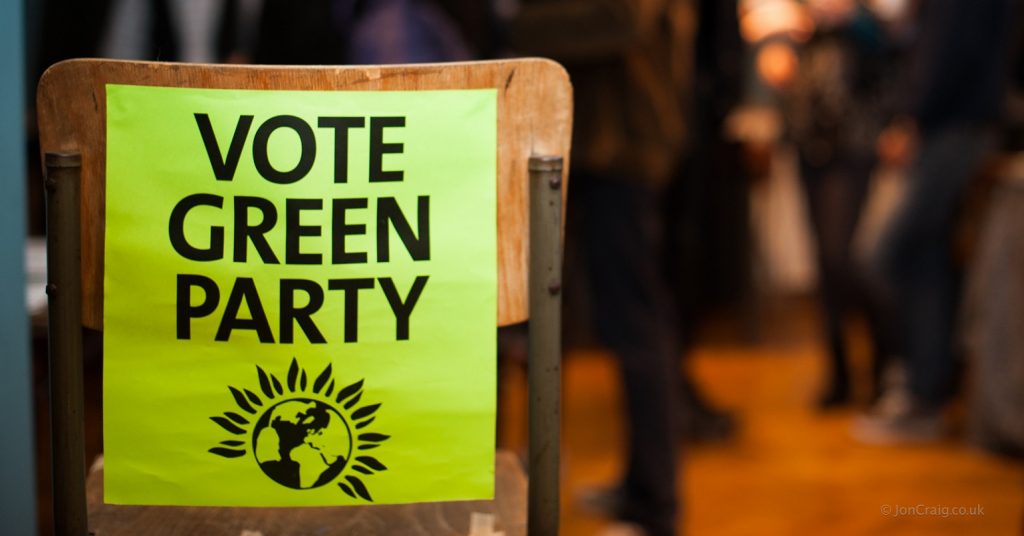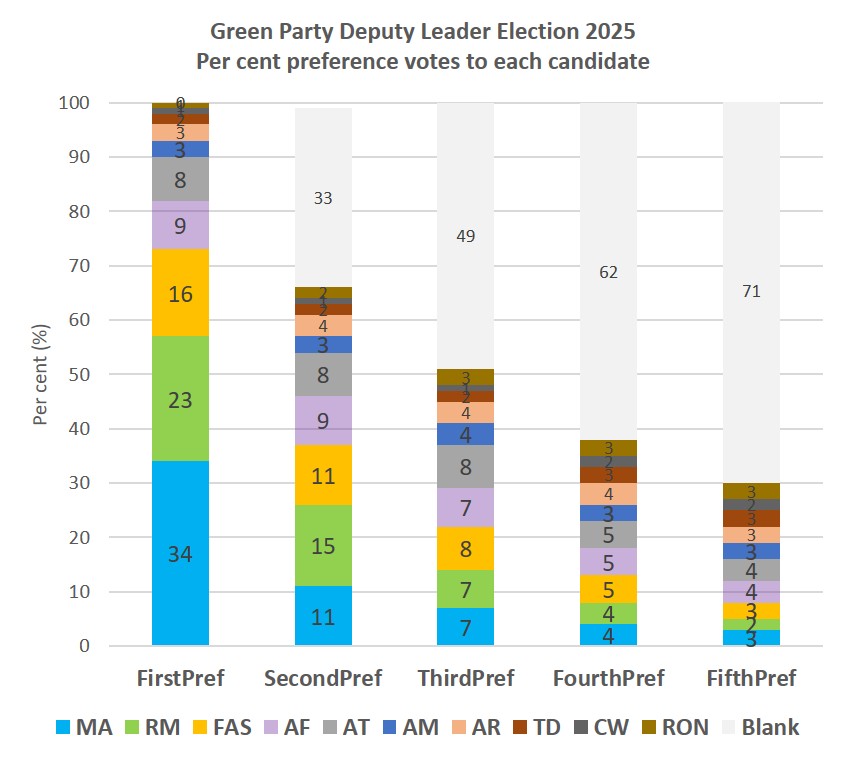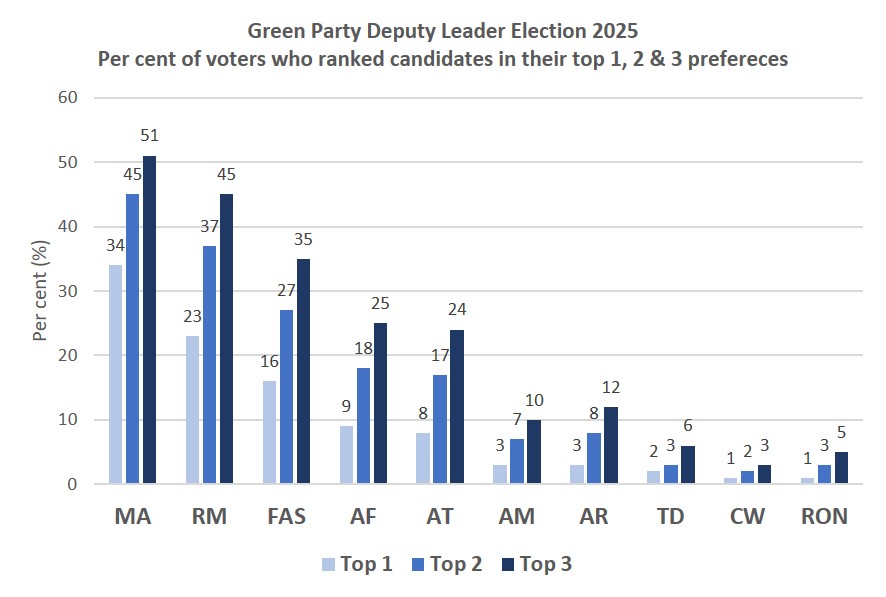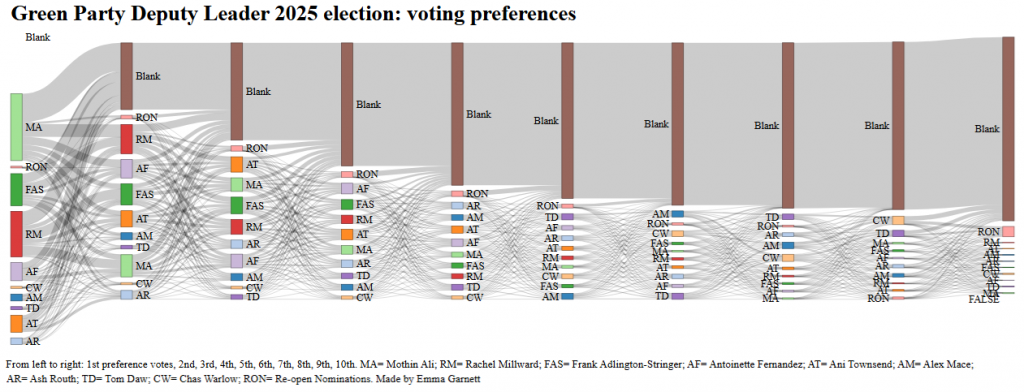5 things we learnt looking under the bonnet of the Green Party deputy leadership election

This year’s Green Party leadership election was a straightforward two horse race between Zack Polanski and the joint ticket of Ellie Chowns and Adrian Ramsay.
However, the deputy leadership race had nine candidates putting themselves forward and of course RON (re-open nominations) bringing the numbers up to a round ten. The ERO (Electoral Returning Officer) wisely didn’t go through all the rounds of vote transfers at the results announcement (complex and impenetrable even for Green internal election enthusiasts) but simply announced the two winners: Mothin Ali and Rachel Millward.
The individual ballot files are now available and give a wealth of information about voters’ preferences and the levels of support for different candidates. And because I am both a data science and Green Party elections nerd, I have been tinkering about with a few analyses.
Here are five things we learnt from these files.
1. Rachel Millward received the most second preferences
The percentage of first preference votes each candidate gets is clear from round 1 of the Single Transferrable Votes. For the other preferences – you need the ballot files.
Rachel Millward got the most second preferences of any candidate with 15 per cent, while Mothin and Frank were tied on 11 per cent.
By the time we get to third preferences it’s a very even field: Mothin Ali, Rachel Millward, Frank Adlington-Stringer, Antoinette Fernandez and Ani Townsend all received 7-8 per cent of preferences.

2.More than half of deputy voters put Mothin Ali in one of their top three places
What about the level of support for candidates across the top three places? This gives a better idea of how widespread their support is.
For this election, the top three places closely follows the order of first preferences. 51 per cent of voters put Mothin in one of their top three spots, then 45 per cent for Rachel Millward, 35 per cent for Frank Adlington-Stringer, 25 per cent for Antoinette Fernandez and 24 per cent for Ani Townsend. Ash Routh – who was just behind Alex Mace on first preferences – overtakes him when looking at top three votes and has 12 per cent to Mace’s 10 per cent. Then we have Thomas Daw on 6 per cent and Chas Warlow on 3 per cent.

3.One third of voters just chose one candidate
In Green Party internal elections, you can put one candidate first and leave it there, or continue to rank everyone listed (including RON).
Most elections in England are first past the post with only one seat available – so we’re very used to just voting for one candidate and this happened here.
Possibly voters weren’t aware they could rank other candidates – or they were motivated to vote at all by their support for one candidate and left it at that.
42 per cent of Mothin Ali’s first preference voters didn’t rank anyone else afterwards (ie, their votes go to “Blank” in the diagram below and in an interactive format here), which was quite a bit higher than Rachel’s (30 per cent) and Frank’s (28 per cent).

4. RON struggled to cut through
Pity poor RON. Whether there were two tickets or nine – RON (re-open nominations) didn’t make headway. For the leadership election with two tickets, RON got a measly 149 first preference votes – 0.6 per cent of the total. For the deputy leadership election with nine, only 136 voters gave RON their first preference – 0.8 per cent of the total. Only 5.2 per cent of voters put RON in their top 3 places for the deputy leadership.
Most Green Party members seemed pretty happy with the choices available.
5. Did the gender balancing rules affect how people vote?
For well intentioned yet badly thought through reasons – the Green Party’s rulebook currently states that deputy leaders have to be of different genders. This prevents two women from being elected – which I find deeply aggravating. If you put two women (or two men) in your top two places, only one can be elected. I would change the rules so that the leadership team had to have at least one woman, and leave it at that – but I digress.
If we look at the top three candidates: Mothin Ali, Rachel Millward and Frank Adlington-Stringer, it looks like people might be more likely to put people of different genders in their top two than we’d otherwise expect.
Mothin Ali had more than twice as many of his first preferencers put Rachel Millward next (19 per cent) compared to Frank Adlington-Stringer (8 per cent); Frank Adlington Stringer’s first preference voters had a similar pattern: almost twice as many went to Rachel (27 per cent) as to Mothin (15 per cent).
However, looking at the fourth candidate Antoinette Fernandez – this pattern breaks down. Her first preference voters were equally likely to go Mothin Ali or Rachel Millward (19 per cent and 20 per cent respectively), but only 7 per cent went to Frank.
Do the gender balancing rules influence how people vote? Maybe, but I have no idea.
Conclusion
And in exhausting news we get to do the leadership and deputy races all over again next year! You wait for a Green Party leadership contest for three years, then two turn up at once.
Post script
If you want to compare 2025’s deputy leadership race to 2022’s (when Zack Polanski was elected) – check out the analysis and Sankey diagram here.
Image credit: Jon Craig – Creative Commons




Thanks for sharing this analysis. I find it really interesting